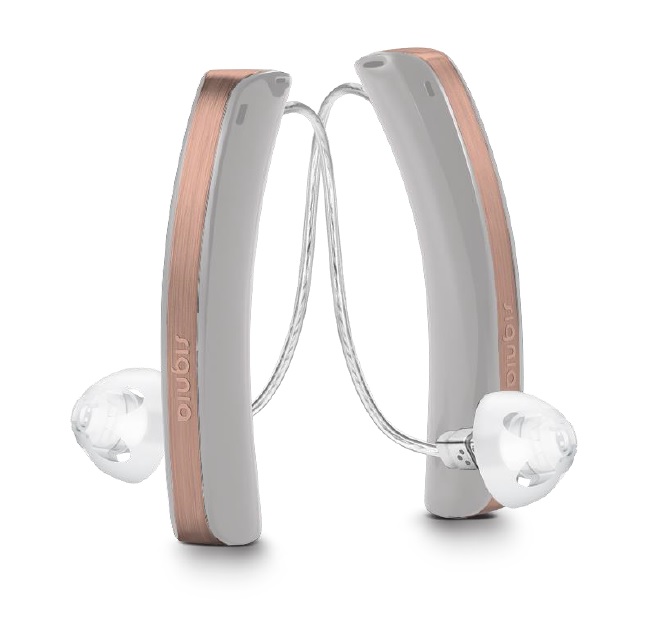Increasing Style, Reducing Stigma: The Styletto Solution
Christina Hakvoort, MBA & Pamela Burton, AuD

Whether it’s the clothes we wear, the cars we drive, or even the food we eat, most of us are concerned with style. And each decade, it seems that style becomes more and more important. Not too long ago, sports shoes came in only two colors — white and black. Today, they are available in most any color or design imaginable. Even medically related items have taken on style. Consider that only a few years back, a broken arm meant wearing a cast that was all white. These days you will see casts decorated to resemble Spiderman, the patient’s favorite sports team, or for the more sophisticated, a Van Gogh painting. Style is knowing who you are.
And of course, style is also important when selecting hearing aids. What patient wants to be wearing the “old fashioned” product? Like the width of a man’s tie, or the length of a woman’s skirt, what is stylish regarding hearing aids also changes over the years. In the early 1990s, research revealed that nearly 90% of BTE hearing aid users found the ITE product to be more “modern” than a BTE, an opinion shared by 93% of ITE users.1 A few years later, when CICs were introduced, 95% of patients preferred the appearance of a CIC compared to the ITE.2 At that time, custom hearing aids in general had a market share of about 80%. But things change. Today, the market share for custom instruments is less than 20%, as behind the ear hearing aids have again become fashionable.
As mentioned earlier, style is knowing who you are, and people don’t want to represent a group that they don’t identify with. For example, certain models of automobiles are thought of as the “cars for old people,” and aggressively avoided by twenty-somethings purchasing their first vehicle. As we all know, this stigma related to a product is a significant issue regarding hearing aids. Unfortunately, in most Western cultures, people who use hearing aids are thought of as old, less able, sometimes even cognitively impaired. This belief is held not only by society in general, but also by many of the people who use hearing aids (referred to as self-stigmatization).3
This stigma begins even before the use of hearing aids. It encourages individuals with hearing loss to adopt a variety of maladaptive strategies. One common strategy is that they will isolate themselves from the world around them. In that way they won’t be asking friends and family members to repeat what they said, which would reveal that they have a hearing loss. Even when these hearing-impaired individuals do engage socially, the effort exerted to conceal the hearing loss involves emotional and cognitive resources, which leads to an overall decrease in quality of life. There often is frustration within the family and the individual’s social groups, as people wonder why he or she isn’t doing something about the problem. This stigma often also leads to an identity or stereotype threat. That is, the person believes that if they wear hearing aids, they will be identified incorrectly, and will not be as much a part of their own stereotyped domain.4 For example, active sports enthusiasts may feel that they are not as “athletic” if they have adopted hearing aids, and therefore, do not fit as well with their athletic friends.
The relationship among hearing loss, hearing aid use, and stigma was revealed by research from Kochkin.5 As expected, his MarkeTrak survey showed that as hearing loss increases, regardless of age, use of hearing aids also increases. However, if we take a grouping, such as those individuals with a moderate hearing loss, the hearing aid adoption rate is over 60% for those 75 years of age or older, but only 20% for those in the 55-65 age range who have the very same degree of hearing loss. The question then becomes—-what if the style of the hearing aid was such that it didn’t meet the stigma criteria. What if the prospective users didn’t feel like they were moving into “old person” territory. Would hearing aid adoption rates then increase for this younger hearing-impaired group?
Over the years there have been several attempts to change the hearing aid form factor to make these instruments more unique, stylish or modern appearing. The results have been mixed. One reason for this is that hearing aid features usually have been sacrificed to create the style desired. So while the product itself might be stylish, it was not recommended by hearing care providers because they knew their patients’ listening needs could be better optimized using hearing aids with additional features. For example, today we have considerable research showing the benefits of bilateral beamforming technology; people with mild-to-moderate hearing losses will have reduced listening effort; and can perform as well in background noise as individuals with normal hearing.6,7 It would be professionally inappropriate, therefore, to deny this technology for an individual simply to give them something that was more stylish. The goal then, when developing a stylish hearing aid, is to improve style, without compromising features and function.
Enter Styletto, the new product from Signia (see Figure 1). Styletto’s slim and sleek design is discrete, modern and stylish. It is both recognizable and memorable. Yet, this form factor is accomplished by maintaining all the key features necessary for optimum speech understanding, sound quality and listening comfort.
To determine the impact that Styletto might have on prospective hearing aid users, a large marketing study was implemented. The goal was to select from a large group, a sub-sample that would be representative of the Styletto target market. To define the amount of hearing loss for each participant, a self-report scale was developed, modeled after that used in MarkeTrak research.8 It consisted of 15 statements which asked the person about their hearing ability. Each statement was scored on a 5-point scale (0-4). The ratings were then summed across the 15 statements, resulting in each person having a summed value ranging between 0 and 60. For the present study, participants selected were those who fell in the 20-40 summed grouping, representing mild-to-moderate hearing loss, typical of a first-time hearing aid user. The group was further narrowed to include only those in the 40 to 65 year old age range (mean=58 years); there was an equal distribution of male and female participants. This resulted in a final sample size of 508 participants. Other demographics for this group included: 92% did not own hearing aids, 17% had inquired about hearing aids from a hearing health care provider, and only 27% had had their hearing loss documented through formal testing.

Two key factors regarding style are attention and recognition. One only has to think of the Nike “Swoosh,” or the hood ornament of Mercedes to understand why this is important. In research with the participants described above, attention and recognition factors for Styletto were studied. The participants first viewed two different photos, and in each photo there were four different hearing aid styles displayed. One of the photos contained Styletto, and the other contained the Signia Motion product. The respondents were then shown a third photo with eight hearing aids of different styles displayed, which included both Styletto and Motion, but also four styles that were not in either of the other two previous photos. The respondents’ task was to identify which hearing aids they had seen before. Styletto was recognized by 88% of the participants, whereas the Motion was only recognized by 47%.
In a related experimental task, the participants were shown two different photos, each showing five different hearing aid styles on display—including the small RIC (Receiver-in-Canal) Signia Pure, the discreet Signia Silk product, and a RIC competitor instrument. The difference between the two photos was that in one, the middle instrument shown was Signia Motion, and in the other photo, the Motion product was replaced with Styletto. While viewing these two photos, the participants were asked: “Which one of these two hearing centers would you most likely go to, to consult with them about hearing aids?” An overwhelming 84% chose the hearing center that was offering Styletto.
These findings clearly show that Styletto attracts attention and is memorable. Moreover, the offering of Styletto has the potential to interest new hearing aid users, and make a particular hearing aid center distinguishable from the others.
Another area of interest related to the introduction of Styletto is how this product influences intent to purchase for prospective hearing aid users. To examine this, the participants were first shown a photo displaying the Signia Pure and the Signia Motion. They were asked the following question: At this hearing center they offer two different hearing aids that meet the requirements of your hearing loss. Which of the two would you be most likely to buy, if any at all? The participants then selected one of the two hearing aid options, or they could select “none.” The results of this selection process are shown in Figure 2. As displayed, the majority of participants chose the Pure product (57%), however, 24% chose “none.”
The participants also were shown a different photo displaying Signia Pure, Signia Motion and this time, Styletto was added. Again, they were asked the following question: At this hearing center they offer three different hearing aids that meet the requirements of your hearing loss. Which of the three would you be most likely to buy, if any at all? The participants selected one of the three hearing aid options, or “none.” The results of this comparative selection are shown in Figure 3.

By far, as displayed in this Figure, the overwhelming favorite was Styletto (65%), picked by many who previously had selected the Pure instrument. Importantly, however, the number of individuals who said “none” dropped from 24% to only 10%; 23% of the 65% who selected Styletto had selected “none” when Styletto was not an option. These data reveal the significant impact that Styletto can have on purchase decisions, and how the net overall outcome is increased market penetration.
Also included in this portion of the study was a comparison that indirectly relates to hearing aid stigma. In viewing the different models of hearing aids, the participants responded for each instrument to the question: Is this hearing aid new and different from other hearing aids? The ratings were significantly higher forStyletto than for any other product. This difference indicates that the unique design of Styletto make it not “just another RIC”, even to non-experts. It is also reasonable to assume, that if a product does not look like a hearing aid, the stigma from using this product will be reduced.

This extensive marketing survey reported here sampled the opinions of individuals aged 40-65 years, with self-reported mild-to-moderate hearing loss–the demographic known to be reluctant to adopt hearing aid use. The data from the survey clearly reveal that the innovative Styletto adds a significant contribution to the Signia portfolio. The research shows that Styletto draws attention, is recognizable and memorable. It is a product that can favorably impact a patient’s decision regarding what hearing aid center to go to for assistance. Adding Styletto as a style option also can increase the decision to purchase hearing aids by a substantial percentage, and by not looking like a hearing aid, hearing aid stigma will be reduced. Moreover, this unique compelling style is accomplished without sacrificing any of the proven Signia processing features that optimize speech understanding and sound quality. In a sleek and slim package we have reduced stigma, enhanced processing and increased style. Styletto is to say who you are without having to speak.

Christina Hakvoort, currently heading the Premium Segment at Sivantos Product Management, has more than 10 years of experience in the hearing instrument business. Prior to joining Sivantos, she worked in the consumer good industry. Christina holds a degree in mechanical engineering and has an MBA from the European School of Management and Technology.

Dr. Burton is the Vice President Product Management & Customer Care for Signia hearing instruments, responsible for the product lifecycle from development through discontinuation. Dr. Burton received her Au.D. from Central Michigan University in 2006 and has been focused on hearing instrument technology and customer focused roles throughout her 31-year career with the company. She has authored numerous articles and a book chapter on amplification and has been a lecturer at local, state and national meetings on amplification topics.